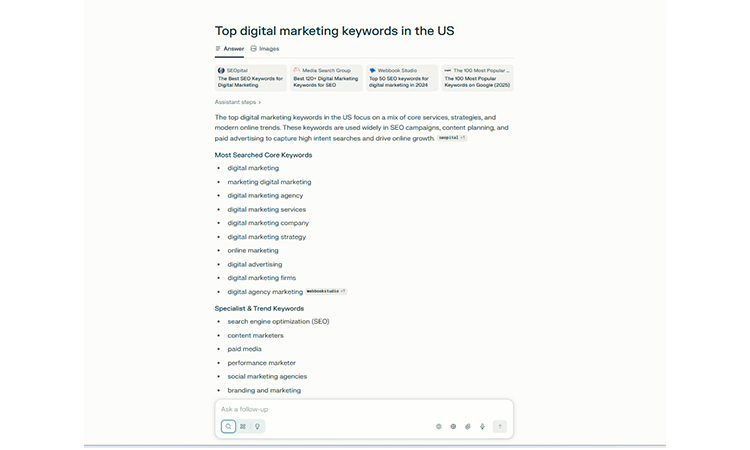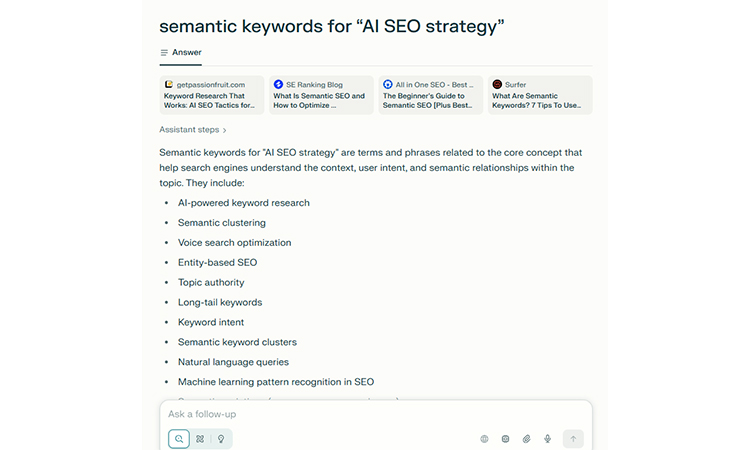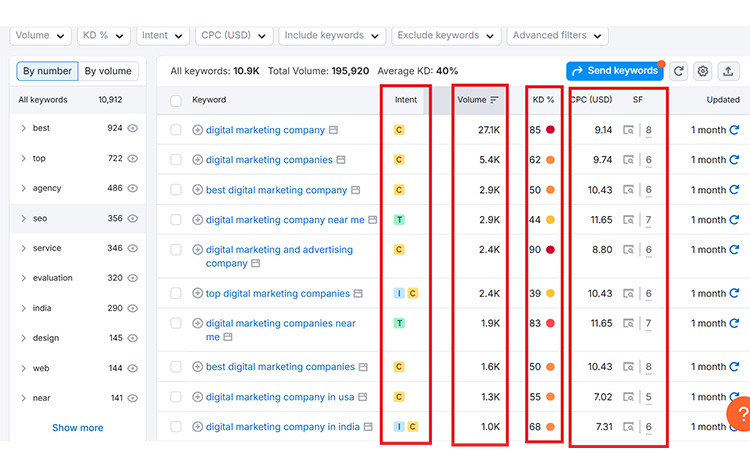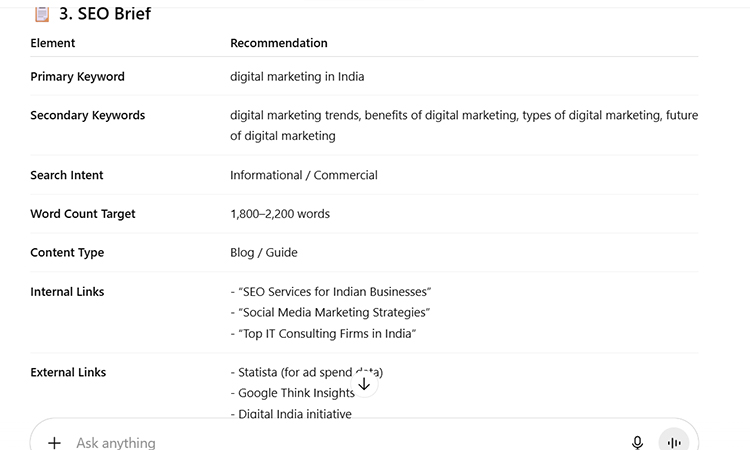When it comes to keyword research, it’s one of the most crucial factors that has a major role in making search engine optimization (SEO) successful. Meanwhile, the process is highly complicated, especially given the age of the growing AI-based search scenario. According to McKinsey and Company, almost 50% of overall Google searches result in AI-powered summaries, and this figure is going to surge up to 75% by 2028. It highlights the biggest shift in search and optimization – Perplexity keyword research helps you overcome it easily.
Perplexity enables marketers to conduct keyword research using a data-driven, strategic methodology that elevates visibility and engagement. By integrating contextual understanding, real-time analysis, and AI-informed search behaviors, Perplexity allows for the identification of highly effective and conversion-focused keywords.
Perplexity identifies the most relevant keywords aligned with the core SEO plan. It enhances the precision and efficiency of keyword research, translating efforts into measurable growth. This discussion will outline a systematic approach to keyword research leveraging Perplexity SEO insights.
What is Perplexity AI?
Perplexity is a highly advanced search engine based on Artificial Intelligence (AI). Being completely different from the traditional search engines, it combines the real-time web data with the precision of large language models. It provides concise, well-written, and most appropriate answers for every query users ask.
Developed on AI models such as Claude and GPT-4, Perplexity provides citation-based outcomes, contextual understanding, conversational search ability, and more. It’s perfect for those who seek verified, accurate, and fast insights.
By using Perplexity AI, you will be able to understand various trending topics, audience intent patterns, and more, apart from emerging keywords. It works as a great research assistant that is perfect for understanding modern search behavior.
Why Use Perplexity for Keyword Research?
Well, the simple answer to this common question is that Perplexity makes the process of keyword research quite easier. It has redefined how digital marketers and search engine optimization professionals work. They do it by combining real-time data insights with AI-based intelligence. It relies extensively on static databases instead of using any keyword tools. Let’s explore more reasons why Perplexity is important for a keyword research plan:
- Perplexity uses advanced natural language models and live web data to provide details on how users search nowadays. It means you will get updated and contextually rich and local keyword ideas based on questions, current trends, user intent, etc. This is something you will not be able to get from any traditional tool.
- By using Perplexity, marketers find it convenient to gather more details about semantic connections between different topics, apart from the searches of keywords. It unveils content gaps, related questions, trending themes, etc. These often inspire more search-optimized and relevant content.
- With the conversational interface of Perplexity, one can redefine their local keyword research strategy with the help of interactive prompts instead of any static lists. Be it getting details of competitor insights, long-term opportunities, or any topical clusters, Perplexity makes the entire process of keyword research simple with full of clarity.
How to Perform Keyword Research with Perplexity SEO?
So, you have already understood the actual importance of Perplexity in keyword research. Now, you may be elated to know how to leverage this tool to find the best keywords, right? We will discuss here step-by-step guide that helps you do it in the most effective way:
- Define your Niche Query or Topic
To start the process of keyword research, you need to first define the main topic or query. You need to understand that the way you use your first query in Perplexity can determine the quality of insights you actually obtain.
So, it’s advisable to use your niche in the question form. For instance, we often use the initial query “top digital marketing keywords” to find the related keywords when using the traditional tools.
Rather than using it in this way, you need to use the query in the question form, like “What are some of the top digital marketing keywords in 2025?” This approach always works best as it prompts Perplexity to provide not only the best-performing terms but also the most important contextual insights. These include related industries, audience intent, content trends, and more.
It’s always advisable to add particular regions, audiences, platforms, etc., to make the results more refined and effective. For instance, you can use “top digital marketing keywords in the US.”

- Analyze Competition and Content Gaps
Getting a detailed overview of your competitors is something that you can’t avoid in any scenario. It gives you complete details of their strategies and also what works well and whatnot.
After gathering complete insights with the help of Perplexity, you need to go through the results deeply. It’s important to take into account that AI-based responses are supported by various source links from valid domains. These types of citations provide you with a great opportunity.
How do Competition Analysis and Content Gaps Help You?
With the detailed insights of competitor analysis, you get a wonderful opportunity to understand the different type of content that ranks for the selected keywords. Once you access the cited sources, you need to look for the following important patterns:
- Keyword Placement
- Keyword Frequency
- Content Format
- Outdated Data or any Missing Subtopics
- Structure and Tone of Any Top-Ranking Pages
With this analysis, you will be able to easily find content gaps, which can be questions or topics that your competitors may not have covered entirely. After this, you can also target these important gaps with optimized content, fresh, etc., to get ahead of your competitors by over performing in SERPs.
- Generate NLP and Semantic Keywords
Perplexity AI comes with Natural Language Processing (NLP) capabilities, which is called its one of its major strengths. So, the main advantage of using this platform is that it’s capable of identifying various semantic keywords, which mainly include phrases and words that take place naturally within a topic cluster.
You can use the following prompts to explore the semantic keywords with Perplexity:
Prompt 1: List some semantic keywords for “AI SEO strategy”.
When we put the same prompt in Perplexity, it reflects the following results.

Prompt 2: List some LSI keywords similar to “healthcare app development”
When we put the above prompt, it delivers the following results. For those interested in understanding more about Generative Engine Optimization, check out our complete guide.

You need to take into account that Perplexity tends to extract conceptually related terms like questions, terms, entities, etc. These are essential to improve the ranking of your content for contextual relevance instead of only keyword density.
Once you incorporate these semantic keywords and NLP, it makes your content align perfectly with Google’s search intent models, be it MUM or BERT. It leads to improved engagement and a higher topical authority.
- Use the Conversational Prompt Approach for Perplexity
You need to always remember that a traditional keyword research tool gives you a list of keywords only whereas Perplexity provides you with complete conversations. Whether you want to expand, clarify, or refine your research strategy, you can do it effectively with the use of a prompt chain.
It’s advisable to start with a wide spectrum and then narrow your focus with the help of natural follow-up questions. For instance, you can go through the following queries:
- What are the top keywords for a digital marketing services blog?
- Show only long-tail variations of digital marketing services blog keywords.
- What are some rising digital marketing services keywords in this category?
For instance, we type the first prompt in the Perplexity AI, and let’s observe what happens.



Well, in the above result, you can already see, Perplexity not only displays the some digital marketing services keywords but also tips for keyword selection and the related prompts.
With the use of conversational prompts, you will be able to get trend-backed variations, richer context, actionable ideas, and more. Therefore, it’s highly important to keep your prompts conversational. Doing this helps you harness the unmatched potential of Perplexity to act like a human. It helps you get the most satisfactory outcomes.
- Analyze Citations and AI Responses
The next important strategy you can follow is to analyze citation-based information that Perplexity provides. This is one of the important features that the majority of AI tools often lack. It provides every response based on real-time references and also from some reputed sources.
A professional AI SEO company looks for everything, be it cited data or an AI response. They also look for the following things:
- They look for whether the source is credible. For instance, it should be from trusted SEO sites, authoritative industry blogs, etc. For instance, when they type “Benefits of Digital Marketing for Businesses”, the tool displays the following results.

As a result, SEO professionals can look for some reliable sources like Simplelearn, business.adobe.com, Answer Engine Optimization: The Next Step After SEO, etc., to gather more related information.
- Next, they can check the exact date of publication of the article by clicking on the reference link. It helps find out whether the content is fresh or not.

When we click directly on the reference link, it shows the exact publication date of the article. Once you validate the citations properly, it ensures your keyword research remains completely verifiable, accurate, data-driven, and more.
- Create a Complete Keyword Map
Once you gather all potential keywords with the help of Perplexity, you need to now organize them completely into a keyword map. It’s advisable to group your keywords in the following important ways:
- Search intent: It should include different categories like navigational, information, transactional, etc.
- Content type: It reflects your content library should include variety of content, including product pages, blog posts, FAQs, landing pages, and more.
- Priority: It should focus on high, medium, and low competition

With this keyword mapping, you can easily see those keywords that can align easily with certain specific pages or also content clusters for your websites. It’s a highly important step when it comes to creating a topic cluster SEO strategy. It boosts internal linking as well as site structure.
The most important thing you can do is to use Notion or Google Sheets to categorize keywords. You need to then assign content creation tasks perfectly according to the map.
- Validate with Tools
One thing you need to know is that Perplexity provides only context and intent with clarity. When you gather your desired keyword, you need to export the same now.

And leverage various keyword research tools to store numerical value.
So, now the question is, what are some keyword research tools? Well, you can consider using the following important tools free:
- Google Keyword Planner: You can use this tool to get details on the competition level and the monthly search volume.

- Other tools like SEMrush, Ahrefs, etc., are good to get details of CPC, keyword difficulty, SERP feature analysis, etc.

- The next important tool you can leverage is none other than Google Trends, which helps you analyze the keyword seasonality and interest growth.
When it comes to cross-verification of keywords, it is of great importance to ensure your Perplexity-discovered keywords are strategically viable and also more relevant.
- Use Follow-Up Prompts
The major advantage of using Perplexity SEO depends on the way you use it post-initial discovery. Once you gather a complete set of your desired keywords, it’s time to use several follow-up prompts to gather more details about actionable layers.

With the interactive process, you will not be able to only find keywords but also understand the actual intent, opportunity, audience, and more behind the same. You can even instruct Perplexity to craft outlines for content according to your top keywords. That’s the reason why it emerged as a full-cycle SEO research assistant.
Important Tips to Improve Keyword Research with Perplexity
To utilize Perplexity for keyword research, you need to follow the most effective tips and tricks. We will discuss here some of the effective tips you can consider to implement to get the most promising outcomes.
- Use Advanced Prompt Cleaning
For Perplexity, the more precise prompts you insert, the better results you can achieve. It’s advisable to avoid inserting keywords like “top digital marketing keywords”. Rather than this, you need to use context-rich and clean prompts as follows:
- For instance, you can use prompts like “What are some of the top-performing SEO keywords for healthcare companies in 2025?”
Keep in mind that an advanced prompt cleaning is something that lets you remove noise, refine your phrase, and guide Perplexity with a clear context. This method works effectively as the AI returns relevant and focused insights rather than generic keyword lists. You can see the example below to understand clearly.

Apart from this, you also need to use several modifiers, including ‘transactional search intent’, ‘long-tail keywords’, ‘emerging topics’, and more, to boost output depth.
- Combine with AI Writing Assistants
Next, an important thing you can do is to combine Perplexity with some popular writing assistants, including ChatGPT. It helps you make your keyword strategy more robust and take it to a content-ready level.
To do it effectively, you need to first use Perplexity for keyword cluster extraction, related queries, trends, etc.

After this, you can use ChatGPT for creating outlines, SEO briefs, and optimized meta descriptions according to those keywords.



This synergy minimizes the actual gap between implementation and research. You can easily recognize the perfect keywords, but also craft top-quality content that can be integrated naturally.
For instance, once you discover a keyword like “AI fintech Apps” and related keywords. Now, you need to use ChatGPT and prompt it to tailor a blog outline around those important terms for making content ready quickly.


- Make sure Queries are Intent-based and Specific
You need to take into account that search intent is highly important in modern SEO. With the AI-based approach of Perplexity, you can align it perfectly. Rather than looking for building intent-driven prompts and isolated keywords, you can proceed with the following:
- List out some commercial-intent keywords for SaaS marketing tools.
- What informational keywords are trending for sustainable healthcare?
Perplexity has the capability of specifying intent and customizing its keywords based on user psychology and personalization. It helps you craft content that matches perfectly what users actually search for. You can, in fact, request keyword intent mapping directly by prompting: “Categorize these important keywords through intent type”.
- Maintain a Great Keyword Insight Log
By using Perplexity, you can easily generate conversation-based and dynamic keywords. It reflects important insights that tend to evolve fast. You need to tailor a keyword insight log by avoiding the goldmine of data.
It’s advisable to use a Notion table or a spreadsheet for documenting:
- Keyword Discovered
- Query Prompt Use Case
- Intent Type
- Notes or Follow-up Questions
- Source Citations
With time, it can become your SEO knowledge base. Apart from this, it also lets you refine your future prompts. Besides, you can also identify various recurring patterns or also emerging opportunities.
You need to take several keywords based on trend level, industry, content potential, and more. These help you to track even long-term performance as well.
Comparing Perplexity vs Traditional Keyword Tools
Let’s go through the following table to understand the real differences between Perplexity and traditional keywords.
| Feature | Perplexity | Traditional Keyword Tools |
| Data Source | It pulls real-time AI-based insights and web data through live internet content. | It depends mainly on several pre-built keyword databases and historical search data to help identify trending topics for your blog posts. |
| Core Approach | Its core approach includes conversational and AI-based query understanding with the help of contextual reasoning. | It’s based on data-driven analysis according to several metrics like CPC, Search Volume, and more. |
| Keyword Discovery Method | It generates keywords with the use case of semantic context, NLP, and more. | It lists keywords mainly by numerical performance signs. |
| Search Intent Analysis | It recognizes automatically and also classifies user intent even within responses. | It needs a completely manual intent mapping or also use of filters for interpreting intent. |
| Real-time Trends | It catches mainly emerging topics and also newly indexed pages quickly. | It updates periodically based on trends. |
| Citation Transparency | It provides source citation for every keyword suggestion or insight. | It doesn’t provide source citation. |
Limitations of Using Perplexity for Keyword Research
Apart from offering numerous advantages and simplifying the keyword research for SEO, using Perplexity for this purpose also has certain limitations. Let’s take a look at all of them:
- It has a lack of quantitative SEO metrics. With Perplexity, you will not be able to get keyword difficulty, search volume, CPC data, and more. This makes it tough when it comes to keyword competitiveness.
- Perplexity generates responses only dynamic from results and web data, which tend to vary based on time, phrasing, or also emerging sources. It envisages full consistency across various repeated searches and can sometimes be unpredictable as well.
- Perplexity quite often overemphasizes many emerging topics that lack proven traffic potential or long-term stability. It requires you to validate these findings with many traditional tools.
- The interface of Perplexity doesn’t have features like data export, advanced filtering, etc. These tend to hinder workflow efficiency for large-scale SEO teams. It remains a valuable resource when it comes to semantic insights and uncovering contextuality compared to any traditional systems.
Prompt Examples for Keyword Research
As we already mentioned, you need to master the top prompts for getting robust keyword insights from Perplexity AI. Compared to traditional SEO keyword research tools, which depend mainly on filtering and static data.
Perplexity responds mainly to natural and conversational prompts within a specific time frame, intent, and audience. The gist of the above discussion is that you need to create your queries smartly; you can easily collect real-time and top-quality SEO opportunities that align perfectly with current trends and user intent.
Let’s understand some of the most effective prompt examples that guide your keyword research process better:
Prompt 1: Give me low-competition keywords about (topic)
It’s a perfect option for getting various untapped keyword opportunities and also various long-tail phrases that help even new websites rank quickly.
Prompt 2: What are trending keywords in (industry) in 2025?
It’s indeed useful for recognizing time-sensitive and emerging topics that can improve topical authority and lure early organic traffic.
Prompt 3: What questions are people asking about (keyword)?
It helps in uncovering many FAQs and information queries, which are appropriate for voice search optimization, blog content, featured snippets, and more.
Wrap Up
So, you may have now understood how Perplexity makes the keyword research process easy and effective. It delivers the finest results by combining conversational intelligence, real-time data, and contextual understanding.
The major strength of Perplexity depends on offering semantic, intent-based, and emerging keywords, though it lacks traditional metrics. Partner with a top-rated AI SEO company to perform keyword research better and get the desired outcomes and take your generative engine optimization (GEO) to the next level.

